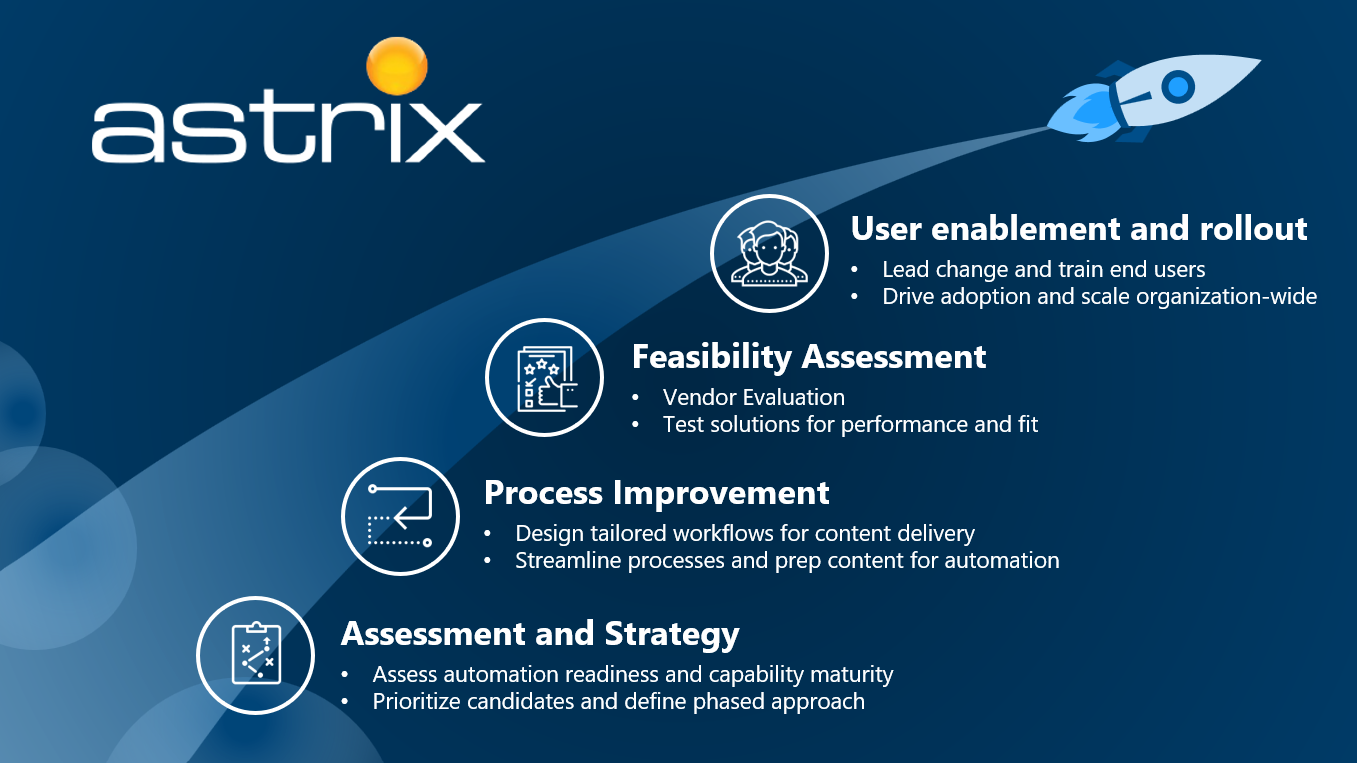
AI for Clinical and Regulatory Documents: From Hype to Value
The allure of Artificial Intelligence (AI) is hard to ignore. From automating repetitive tasks to deriving insights that drive strategy, organizations everywhere are sprinting to embrace AI solutions. According to Gartner, by 2026 60% of organizations will abandon AI projects unsupported by AI-ready data.
But as more companies race to deploy AI, many overlook fundamental questions that can make or break their investment. Like any transformative initiative, charging ahead without preparation can lead to costly missteps, operational headaches, or failure.
In Part One of our three-part series, we explore how to assess your organization’s AI readiness for automating Regulatory and Clinical trial content. In Part Two, we delve into the essential foundation for AI success: Structured Content Authoring (SCA). Finally, in Part Three, we examine what AI-enabled content generation truly entails, why it’s gaining momentum today, and how organizations can effectively embrace it.
Below, we explore key considerations you must address before and during your AI journey and outline essential steps to secure a solid return on your investment.
Is Everyone Bought In? Users and Leadership Alike
When thinking about implementing a new AI tool or automation process, companies need to think of it more than a technical change, they need to look at it as a cultural change. If leadership isn’t fully aligned on the “why,” or if users see AI as a threat rather than an enabler, your initiative may stall.
Why this matters:
Imagine pouring thousands of dollars into an AI solution(s), only to watch it fail because your end-users don’t trust it. End-user input is key. These solutions are designed to enhance their process, not replace their contribution. Early alignment ensures adoption later. Teams that are accustomed to their current process and resistant to change may not be willing to adapt. Getting leadership to clearly communicate the benefits, set expectations, and foster transparency is extremely critical.
Do You Have the Internal Bandwidth to Implement AI?
AI implementation isn’t plug-and-play. It often involves:
- Reviewing and cleaning up legacy systems
- Assessing if your tech stack is “AI ready”
- Standardizing and streamlining your processes
- Determining whether your organization is centralized (easy data consolidation) or decentralized (requiring data from multiple disconnected silos)
- Allocating time from already busy teams to guide and test the new processes and systems
Why this matters:
Burnout is real. Asking your internal teams to balance AI initiatives on top of daily deliverables, compliance needs, and submission deadlines may spread them too thin.
An easy way to remove this burden from your internal team is to use an expert partner to avoid burnout. Contact us to learn how a strategic partner can help streamline your AI automation, from Vendor Evaluation and implementing Proof of Concepts (PoC) to Training end users.
Are Your Current Processes Ready for AI?
Before integrating AI into your operations, it is critical to assess how your existing processes, systems, and people are aligned. AI does not fix broken processes; it amplifies them, whether good or bad. A readiness assessment can help ensure your AI investments deliver meaningful value.
- Are your workflows documented, standardized, and consistent?
- AI thrives on structure and predictability. If your workflows are well-documented, follow clear guidelines, and are executed consistently across teams, AI can more easily learn patterns and deliver reliable outputs.
- Why it matters: Without standardized processes, AI models may struggle with inconsistent data, making outcomes unreliable.
- How to strengthen this: Ensure that key processes are mapped out, kept up to date, and enforced across departments.
- Content standardization relies on clear structures, templates, and training for end users.
- When AI is applied to content-heavy workflows, such as creating Informed Consent Forms (ICFs), or Regulatory documents, standardized formats and templates are essential.
- Why it matters: AI models trained on structured, templated content are better at replicating quality and maintaining compliance.
- How to strengthen this: Develop templates, style guides, and conduct training so employees understand how to create and use consistent content.
- Do your workflows rely heavily on tribal knowledge or manual interventions?
- Many organizations operate on undocumented know-how passed down informally, known as tribal knowledge, or depend on human workarounds to bridge gaps in broken processes.
- Why it matters: AI cannot replicate undocumented expertise. Without clear logic and repeatable rules, automation will be patchy or fail outright.
- How to strengthen this: Capture key knowledge in SOPs, flowcharts, or knowledge bases to reduce dependence on specific individuals.
- Are your end users trained to validate or correct AI outputs?
- AI is rarely perfect out of the box. Human oversight is essential, especially in the early stages of adoption.
- Why it matters: Compliance is key for Regulatory and Clinical documents. Employees need to understand how to critically review AI recommendations, catch errors, and provide feedback that helps improve the models.
- How to strengthen this: Invest in change management and training so staff know how to interpret AI outputs and when to intervene.
- Have you identified the high-impact areas where AI can add value?
- The highest ROI often comes from automating repetitive, rules-based tasks or augmenting complex decision-making with predictive insights.
- Why it matters: If you try to automate low-value or poorly understood processes, you may waste time and resources.
- How to strengthen this: Conduct a process audit to identify bottlenecks, inefficiencies, and opportunities where AI can drive measurable improvements.
- Have you reviewed your processes before applying AI, or are you trying to automate inefficiencies?
- Automating a bad process just helps you do the wrong thing faster.
- Why it matters: Applying AI to flawed or outdated processes can entrench inefficiencies, making problems harder to unwind later.
- How to strengthen this: Use process improvement tools, such as Lean or Six Sigma reviews, to streamline workflows before layering AI on top.
Why this matters:
If your processes aren’t streamlined, AI may end up magnifying inefficiencies. For example, an unstructured 100-page document will be much harder to automate than a standardized 20 to 40 page document that follows clear guidelines.
We recommend conducting a content audit, aligning documentation to ICH guidelines, and ensuring your internal standards support future automation.
Three Essentials for Maximizing Your AI Investment
- Determine what to automate.
Look at your internal processes and pain points to identify what truly benefits from AI, don’t automate for automation’s sake. - Ensure data readiness.
Standardize formats, ensure your data is accurate, complete and accessible for AI to deliver value. - Solidify structured content processes.
Follow content authoring standards (like ICH guidelines) to minimize complexity and make automation smoother.
Feeling Overwhelmed?
You’re not alone!
Many organizations find balancing daily operations with transformative projects daunting. That’s why outsourcing to a strategic consulting partner can remove the burden from your team while delivering the full benefits of AI.

Why Partner with Astrix?
Unlike many vendors who drop in a tool and leave you to figure it out, Astrix takes time to understand your unique operations. We engage your leadership, collaborate with your stakeholders and Subject Matter Experts (SMEs) across departments, and design a plan tailored to your needs. From strategy to adoption, we provide dedicated experts who troubleshoot issues, answer questions, and guide you through each step.
When it comes to a major investment like AI, having a partner who has helped other companies like yours can be the difference between success and costly setbacks.
Contact us to learn how we can help you get AI ready now.
Astrix Resources
Webinar: Why Hyperautomation is the KEY to SPEED and SCALE in life sciences R&D
Clinical Research White Paper – Enhancing Transparency & Efficiency Throughout the Trial Lifecycle for AI Readiness
White Paper: Roadmap to AI Data Readiness in R&D Labs
Case Study: LabWare Centralized Data Review for a Global Biopharmaceutical Company
Overview A global biopharmaceutical company specializing in discovery, development,... LEARN MOREWhite Paper: Managing Data Integrity in FDA-Regulated labs.
New White Paper LEARN MORELET´S GET STARTED
Contact us today and let’s begin working on a solution for your most complex strategy, technology and strategic talent services.
CONTACT US



